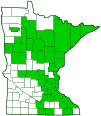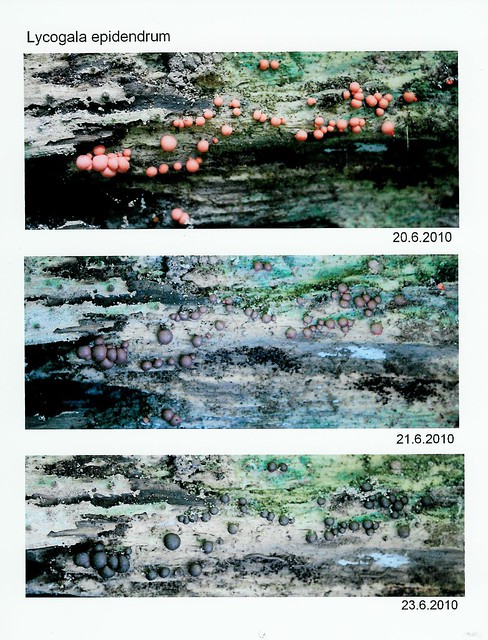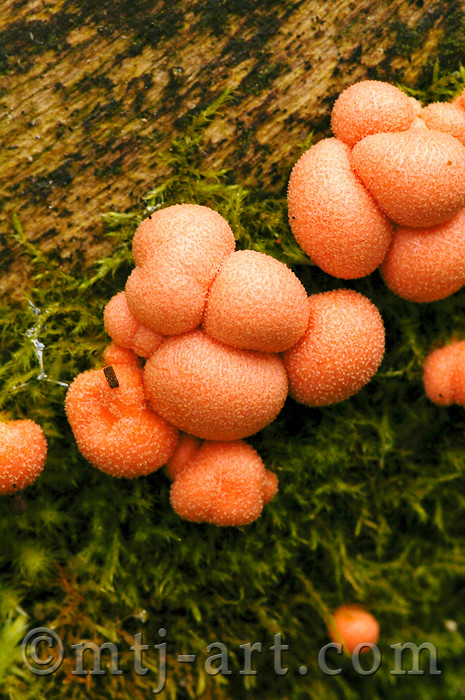wolf’s milk slime mold
(Lycogala epidendrum)
Conservation • Description • Habitat • Ecology • Distribution • Taxonomy
Conservation Status |
|
|||||||
| IUCN Red List | not listed |
|||||||
| NatureServe | not listed |
|||||||
| Minnesota | not listed |
|||||||
Description |
||
Wolf’s milk slime mold is a common and widespread plasmodial slime mold. It is found from June through November, usually in groups, sometimes scattered, on well rotted logs and other dead wood. The fruiting body is a plump, pillow-like mass (aethalium) of protoplasm enclosed in an surface crust. It looks like a small puffball. Each aethalium is globe-shaped to hemispherical and ⅛″ to ⅝″ in diameter. It is pink at first and filled with a pink paste that has a texture often compared to toothpaste. As it matures it becomes yellowish-brown to olive brown, darkening as it ages. The interior of a mature aethalium is a dry, powdery, pinkish-gray mass of spores. It is not edible. |
||
Similar Species |
||
Habitat and Hosts |
||
Logs and other dead wood |
||
Ecology |
||
Season |
||
June to November |
||
Distribution |
||||
|
Sources |
|||
| 9/7/2022 | ||||
Occurrence |
||||
Common and widespread across North Amerca |
||||
Taxonomy |
|||
Kingdom |
Protozoa (protozoans) |
||
Phylum |
Mycetozoa (slime molds) |
||
Class |
Myxomycetes (true slime molds) |
||
Subclass |
Lucisporomycetidae |
||
Superorder |
Trichiidia |
||
Order |
Reticulariales |
||
Family |
Reticulariaceae |
||
Genus |
Lycogala |
||
Higher ranking The ranking on MinnesotaSeasons.com for this species follows iNaturalist. |
|||
Synonyms |
|||
wolf’s milk slime mold (Lycogala epidendrum var. cristatum) wolf’s milk slime mold (Lycogala epidendrum var. tessellatum) |
|||
Common Names |
|||
toothpaste slime wolf’s milk wolf’s milk slime wolf’s milk slime mold |
|||
Glossary
Aethalium
The large, pillow-like, fruiting body with an outer crust of some slime molds, formed by the fusion of many plasmodia into a single functional mass. Plural: aethalia.
Visitor Photos |
|||||
Share your photo of this slime mold. |
|||||
| This button not working for you? Simply email us at info@MinnesotaSeasons.com. Attach one or more photos and, if you like, a caption. |
|||||
Luciearl |
|||||
 |
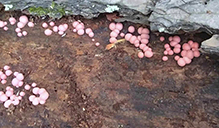 |
||||
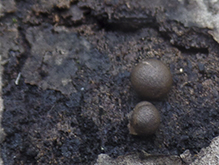 |
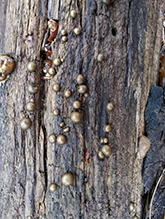 |
||||
Honey Fae (Farah) |
|||||
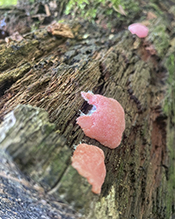 |
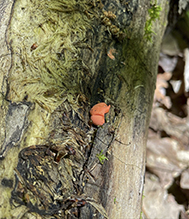 |
||||
Beth Harrington |
|||||
on a downed log in a wetlands area |
|||||
 |
|||||
MinnesotaSeasons.com Photos |
|||||
|
|||||

Visitor Videos |
|||
Share your video of this slime mold. |
|||
| This button not working for you? Simply email us at info@MinnesotaSeasons.com. Attach a video, a YouTube link, or a cloud storage link. |
|||
Other Videos |
|||
| Wolf's Milk Slime/ Lycogala epidendrum The Roaming Gnome...Glenn Munro! VRCM/SkyWarn |
|||
About
Published on May 13, 2016 Little round, reddish pink balls. Exudes pinkish-grey paste when popped. Listed as inedible. This specimen was located in central missouri. |
|||
| Nature Insights - The Wolf's Milk Slime Mold at Spier's Old School Grounds Roger Griffith |
|||
About
Published on Oct 30, 2014 These pink blobs represent huge single celled Wolf's Milk or Wolf's Blood slime molds with thousands of nuclei that reach this size following long periods of feeding on bacteria, yeast, etc. The feeding stage is called a syncytium and the aethial stage is the reproductive stage where the mold goes a brown colour and changes into thousands of spores that are dispersed by wind, rain, etc. |
|||


Created: 10/8/2018
Last Updated:
